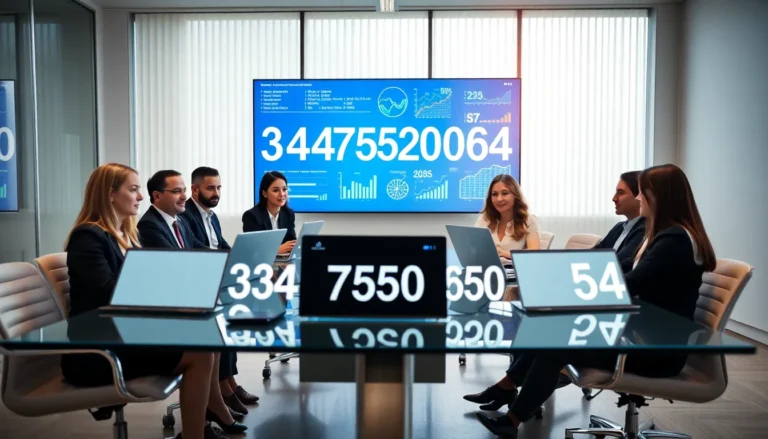Table of Contents
ToggleImagine a world where processing invoices doesn’t require a Ph.D. in tax law or a limitless supply of caffeine. Invoice OCR software is here to turn that dream into a reality. This technology automates the tedious task of data entry, allowing businesses to focus on what truly matters. Here’s a deep jump into why it’s time to say goodbye to manual labor and hello to streamlined efficiency.
What Is Invoice OCR Software?

Invoice OCR (Optical Character Recognition) software is a game-changer for businesses that deal with countless invoices on a daily basis. At its core, this technology converts paper documents into editable and searchable data. Instead of flipping through a mountain of invoices, users can now scan documents, and voila, the software extracts relevant information automatically. It recognizes text, dates, amounts, and even line items, transforming them into digital formats. Let’s put it simply: if invoices could talk, they’d be singing praises for this technology.
By employing OCR, invoice processing becomes as easy as pie. Just point, click, and let the software do the heavy lifting. It can save hours of manual work, reduce human error, and provide faster access to crucial information.
Benefits of Using Invoice OCR Software
The advantages of using invoice OCR software are not just a marketing gimmick: they’re substantial. First on the list is the sheer efficiency it brings to the table. Businesses can process invoices in a fraction of the time it would normally take. Imagine being able to digitize hundreds of invoices in minutes.
Next up is accuracy. Manual data entry often leads to mistakes, perhaps a date gets flipped or a dollar sign misinterpreted. OCR software dramatically reduces these errors, ensuring that the data pulled aligns perfectly with what’s on the original invoice.
Money-saving benefits also abound. By automating invoice processing, companies can cut down on labor costs. Those hours spent entering data can be redirected to more strategic efforts, like planning for expansion or building client relationships. Finally, real-time access to invoices keeps teams informed, enabling quicker decision-making.
Key Features of Invoice OCR Software
When it comes to features, invoice OCR software doesn’t skimp. Here are some key functionalities that set it apart:
Data Extraction
This feature is the heart of the system. It smartly recognizes various fields on invoices, including vendor names, invoice numbers, dates, and totals, extracting them for easy retrieval.
Invoice Validation
Many systems come with built-in validation tools that cross-check extracted data against existing databases. This functionality prevents fraudulent claims from slipping through the cracks.
Integration Capabilities
Modern OCR software can often integrate seamlessly with existing accounting or ERP systems. This means hassle-free data transfer, allowing businesses to maintain robust financial records without added legwork.
User-Friendly Interface
A well-designed interface makes it easy for users to navigate and use different features effectively. The smoother the experience, the higher the chance for adoption across teams.
Choosing the Right Invoice OCR Software
Selecting the right invoice OCR software can feel overwhelming given the plethora of options available. Start by evaluating specific business needs, does the company handle a high volume of invoices? What level of accuracy is required?
Next, consider scalability. As businesses grow, their software must adapt accordingly to increasing volumes and complexities. Also, check for integrations with existing systems to ensure a smoother experience. If possible, leverage free trials or demos to gauge usability firsthand. After all, the last thing anyone wants is tech that’s harder to use than traditional methods.
Implementation and Integration of Invoice OCR Software
Implementing invoice OCR software can be straightforward if done right. The first step generally involves setting up a robust environment, ensuring the necessary hardware is in place and that users have a clear understanding of how the software operates.
Training sessions are crucial here. By investing in comprehensive training, organizations can increase adoption rates and reduce frustration during the learning curve. Integration with existing systems should ideally be automated to minimize disruptions. Once everything is set up, it becomes a matter of monitoring performance and making adjustments as necessary.
Common Challenges with Invoice OCR Software
Even though the advantages, invoice OCR software is not without its challenges. One common issue is dealing with poor-quality documents. If an invoice is faded or crumpled, the software might struggle to extract accurate data. Also, varying formats from different vendors can complicate the extraction process.
User resistance is another hurdle. Employees may be hesitant to embrace new technology, particularly if they’re comfortable with the traditional manual methods. Addressing these concerns through thorough training and showcasing success stories can help break down resistance.
Future Trends in Invoice OCR Technology
As technology evolves, so too does invoice OCR. Future trends point towards increased use of machine learning to enhance data recognition capabilities. This will allow software to learn from previous interactions, continually improving accuracy over time.
Also, cloud-based solutions are on the rise, enabling users to access their invoice data from anywhere, at any time. This flexibility is increasingly becoming a necessity in a world where remote work is common. Besides, advancements in AI could integrate even deeper validation mechanisms, ensuring that duplicate invoices and fraud are caught before any payments are processed.







